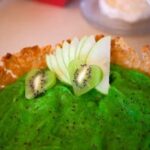Lemon cakes have long been a favorite dessert choice, thanks to their zesty and refreshing flavor. But what if we told you that lemon cake can be more than just a tasty treat?
With the art of lemon cake decoration, you can transform a simple dessert into a stunning centerpiece that delights both the eyes and taste buds. In this article, we will explore the world of lemon cake decoration, from basic recipes and techniques to creative ideas that will inspire your own edible masterpieces.
When it comes to desserts, lemon cakes have always held a special place in people’s hearts. Their tangy yet sweet flavor provides a burst of freshness that is unparalleled. However, it’s not just the taste that makes these cakes so popular; it’s also their versatility. Lemon cakes can be dressed up or down, making them suitable for casual gatherings or elegant affairs.
But what truly sets a stunning lemon cake apart from an ordinary one is its presentation. The art of lemon cake decoration takes this beloved treat to new heights by adding intricate designs, vibrant colors, and unique textures. Whether you’re planning on celebrating a special occasion or simply want to impress your guests with an eye-catching dessert, mastering the art of lemon cake decoration is sure to elevate your culinary skills.
In the following sections, we will delve into the essentials of baking a delicious lemon cake and explore various decorative elements that bring out its natural beauty. From buttercream frosting variations to creative decorating techniques using fondant decorations and stencils, we’ll guide you through each step necessary to create a show-stopping masterpiece. So get ready to unleash your creativity as we embark on an exciting journey into the art of lemon cake decoration like never before.
Lemon Cake Basics
One of the key elements to creating a delicious lemon cake is using the right ingredients. Here is a basic lemon cake recipe that will produce a tangy and moist cake that serves as an excellent canvas for your decorative ideas:
Ingredients:
- 2 cups all-purpose flour.
- 1 1/2 cups granulated sugar.
- 1 tablespoon baking powder.
- 1/2 teaspoon salt.
- 1 cup unsalted butter, softened.
- 4 large eggs.
- Zest of 2 lemons.
- Juice of 1 lemon.
- 1 cup buttermilk.
Instructions:
- Preheat your oven to 350°F (175°C) and prepare two round cake pans by greasing them and lining the bottoms with parchment paper.
- In a large mixing bowl, whisk together the flour, sugar, baking powder, and salt until well combined.
- Add in the softened butter, eggs, lemon zest, and lemon juice. Mix on medium speed until the batter is smooth and well incorporated.
- Slowly pour in the buttermilk while continuing to mix on low speed until fully combined.
- Divide the batter evenly between the prepared cake pans and smooth out the tops with a spatula.
- Bake for about 25-30 minutes or until a toothpick inserted into the center comes out clean.
- Let the cakes cool in the pans for about 10 minutes before transferring them onto wire racks to cool completely.
In addition to following this recipe, there are some tips that can help you achieve an even better outcome with your lemon cake. Firstly, make sure to use fresh lemons for both their zest and juice to ensure maximum flavor. It’s also important not to overmix your batter once you’ve added in the flour – just mix until everything is incorporated to avoid a dense texture.
Remember that every oven is different, so keep an eye on your cakes as they bake and adjust the baking time if necessary. And finally, allow your cakes to cool completely before attempting to frost or decorate them, as a warm cake can cause frosting to melt or slide off.
Now that you have mastered the basic lemon cake recipe and understand the importance of using quality ingredients, it’s time to move on to the exciting part – exploring different decorative elements for your lemon cake.
Lemon-themed Decorative Elements
Lemons are not only a popular ingredient for baking but can also act as a vibrant and refreshing decorative element for lemon cakes. Incorporating lemon-themed decorative elements into the design of a cake can add visual appeal and enhance the overall flavor profile. In this section, we will explore different lemon-themed decorative elements that can be incorporated into the cake design.
One simple yet effective way to incorporate lemon into cake decoration is by using lemon zest. The zest of a lemon adds a burst of citrus flavor and bright yellow color to the cake. It can be sprinkled over the top of the frosted cake or used as a garnish around the edges.
Lemon slices are another decorative element that can be placed on top of the cake or used to created layered designs within the frosting. These slices not only add visual interest but also intensify the lemon flavor in each bite.
For those looking to take their lemon cake decoration to the next level, candied lemon peels can be an excellent choice. Candying lemon peels involves simmering them in a sugar syrup until they become translucent and slightly chewy. These candied peels make for elegant decorations that can be draped over the edges of the cake or arranged in artistic patterns on top.
| Lemon-Themed Decorative Elements |
|---|
| Lemon Zest |
| Lemon Slices |
| Candied Lemon Peels |
Buttercream Frosting Variations
Lemon Cream Cheese Frosting
One delicious variation of buttercream frosting that pairs perfectly with lemon cake is lemon cream cheese frosting. This tangy and creamy frosting adds an extra layer of flavor to the cake while also providing a smooth and luscious texture. To make lemon cream cheese frosting, you will need:
- 8 ounces (226g) cream cheese, softened.
- 1/2 cup (115g) unsalted butter, softened.
- 4 cups (480g) powdered sugar.
- 1 tablespoon freshly squeezed lemon juice.
- Zest of one lemon.
Start by beating the softened cream cheese and unsalted butter together until they are well combined and creamy. Gradually add in the powdered sugar, about 1 cup at a time, making sure to mix well after each addition. Once all the powdered sugar is incorporated, add in the freshly squeezed lemon juice and zest and beat until everything is smooth.
Lemon Swiss Meringue Buttercream
For those who prefer a lighter and fluffier texture in their frosting, try making a batch of lemon Swiss meringue buttercream. This smooth and velvety frosting has a silky consistency that beautifully complements the tartness of the lemon cake. Here’s what you will need:
- 4 large egg whites.
- 1 cup (200g) granulated sugar.
- 1 ½ cups (345g) unsalted butter, softened.
- 1 teaspoon vanilla extract.
- Zest of two lemons.
- Juice of one lemon.
To make this light yet rich frosting, start by whisking together the egg whites and granulated sugar in a heatproof bowl set over simmering water. Continue whisking until the sugar has dissolved completely and the mixture reaches approximately 160°F (71°C). Remove from heat and transfer to a stand mixer fitted with a whisk attachment. Beat the mixture on high speed until it reaches stiff peaks and has cooled to room temperature.
Next, switch to the paddle attachment and gradually add in the softened butter, about 1 tablespoon at a time. Once all the butter is incorporated, beat on medium-high speed for a few minutes until the frosting becomes creamy and smooth. Finally, add in the vanilla extract, lemon zest, and lemon juice, beating until everything is well combined.
Tips for Achieving Perfect Frosting Consistency
When it comes to frosting your lemon cake, achieving the right consistency is key. You want your frosting to be easy to spread or pipe onto the cake while still holding its shape. Here are some tips to help you achieve that perfect balance:
- Make sure your butter is softened but not melted. This will ensure that it incorporates smoothly into your frosting without making it too runny.
- Gradually add your powdered sugar or granulated sugar during the mixing process, stopping periodically to check the consistency and adjust as needed.
- If your frosting becomes too thin or runny after adding flavorings like lemon juice or extracts, you can thicken it up by adding more powdered sugar bit by bit until you reach the desired consistency.
- On the other hand, if your frosting turns out too thick,stiff or dense for spreading or piping, you can loosen it up by adding a small amount of milk or cream, mixing well after each addition until you reach the desired texture.
By experimenting with different variations of lemon-flavored buttercream frostings and mastering their consistencies, you can enhance both the taste and appearance of your lemon cake decoration. Whether you prefer tangy cream cheese or silky Swiss meringue buttercream, these frostings will make every bite of your lemon cake absolutely delightful.
Creative Decorating Techniques
When it comes to lemon cake decoration, there are numerous creative techniques that can transform a simple cake into a work of art. One popular technique is the rosette technique, which involves piping swirls of buttercream frosting onto the cake to resemble lemons. By using different shades of yellow and green frosting, you can create a visually stunning lemon-shaped cake that will wow your guests.
Another technique that adds an elegant touch to lemon cakes is the use of fondant decorations. Fondant allows for intricate designs and can be shaped into various citrus-themed elements such as lemons, leaves, or flowers. These fondant decorations can be placed on top of the cake or used as borders around the edges for added visual appeal.
For those who prefer a simpler approach, stencils can be used to create intricate designs on the surface of the cake. Lemon-shaped stencils or patterns inspired by citrus fruits can be dusted with powdered sugar or cocoa powder onto the cake’s surface, leaving behind a beautiful and professional-looking design.
In addition to these techniques, edible flowers can also add a pop of color and elegance to any lemon cake decoration. Flowers such as lavender blossoms or pansies not only provide visual beauty but also complement the tangy flavor of lemon. Adding a sprig of thyme or rosemary to garnish the cake further enhances its taste and appearance.
These creative decorating techniques offer endless possibilities for turning a simple lemon cake into a masterpiece. Whether you opt for intricate fondant designs, playful rosette patterns, or elegant stencil embellishments, these techniques will elevate your lemon cakes and make them stand out at any gathering.
Colorful Citrus Decorations
When it comes to decorating a lemon cake, incorporating colorful citrus fruits can add vibrancy and visual appeal to the overall design. Oranges, limes, and grapefruits can be used alongside lemons to create a stunning and eye-catching centerpiece. Balancing the flavors of different citrus fruits is also important to ensure a harmonious taste experience. In this section, we will explore various ways to incorporate colorful citrus decorations into your lemon cake.
One popular way to incorporate citrus decorations is by using citrus slices as garnishes on top of the cake. Thinly sliced oranges, limes, and grapefruits can be arranged in a circular pattern or scattered sporadically across the surface of the cake. This not only adds visual interest but also provides a burst of citrus flavor with each bite.
Another creative technique is to make candied citrus peels for decorating the lemon cake. These vibrant and shiny peels can be made by simmering thin strips of orange, lime, or grapefruit peels in a sugar syrup until they become translucent. Once cooled, they can be twisted into elegant shapes or placed strategically on top of the cake for an added touch of sophistication.
Incorporating citrus zest into the frosting or batter is another way to infuse even more citrus flavor into your lemon cake. Lemon zest can be mixed with buttercream frosting or added directly into the batter before baking. This enhances both the taste and aroma of the cake, giving it an extra refreshing burst that pairs perfectly with the tangy lemon flavor.
| Citrus Decoration Ideas | Description |
|---|---|
| Citrus Slice Garnishes | Thinly sliced oranges, limes, or grapefruits arranged on top of the cake |
| Candied Citrus Peels | Shiny and translucent peels made by simmering citrus peels in a sugar syrup |
| Citrus Zest Infusion | Adding citrus zest to frosting or batter for enhanced flavor and aroma |
By incorporating colorful citrus decorations into your lemon cake, you can create a visually stunning dessert that is not only delicious but also aesthetically pleasing. Experiment with different arrangements and combinations of citrus fruits to find the design that best suits your taste and style. Remember, with some creativity and a lot of zest, you can transform an ordinary lemon cake into an extraordinary masterpiece.
Floral and Herb Combinations
When it comes to lemon cake decoration, incorporating floral and herb elements can add a touch of elegance and enhance both the flavor and appearance of the cake. Floral and herb combinations not only provide a beautiful aesthetic but also contribute unique flavors that complement the tangy taste of lemon. Here are some ideas for incorporating floral and herb elements into your lemon cake designs:
- Lavender: Known for its lovely fragrance, lavender pairs well with lemon to create a delicate and sophisticated flavor profile. Scatter dried lavender buds over the frosting or infuse lavender into the cake batter for a subtle taste.
- Thyme: This herb brings an earthy, herbal note that beautifully contrasts with the bright citrus flavors of lemon. Sprinkle fresh thyme leaves on top of the frosting or infuse thyme into a simple syrup to brush on each layer of the cake before frosting.
- Edible Flowers: Adding edible flowers such as pansies, violets, or marigolds not only enhances the visual appeal but also introduces various subtle flavors to each bite. Make sure to use organic flowers that are safe for consumption and avoid spraying them with any chemicals.
- Mint: The refreshing taste of mint can provide a cooling sensation when paired with zesty lemon. Create mint-infused sugar by blending fresh mint leaves with granulated sugar, then sprinkle it over the frosting or incorporate it into the cake batter.
Experimenting with different floral and herb combinations allows you to personalize your lemon cake decoration while expanding your creative possibilities. Keep in mind that when using these natural additives, it’s important to use high-quality ingredients that are pesticide-free and safe for consumption.
Here is an unordered list summarizing this section:
- Lavender adds a delicate touch.
- Thyme brings an earthy flavor contrast.
- Edible flowers introduce various subtle flavors.
- Mint offers a refreshing pairing option.
Lemon Cake Evolution
As with any other culinary art form, the world of lemon cake decoration has evolved over time. From classic and traditional designs to modern and innovative presentations, bakers and decorators have pushed the boundaries of creativity when it comes to decorating this beloved citrus-infused dessert.
Traditionally, lemon cakes were adorned with simple lemon glazes or dusted with powdered sugar for a clean and elegant look. However, as baking techniques and decorating tools have advanced, so too have the possibilities for lemon cake decoration. Today, bakers are incorporating intricate designs and vibrant colors to create visually stunning cakes that are truly works of art.
One trend that has gained popularity in recent years is the use of abstract patterns and geometric shapes in lemon cake decoration. Bakers are using techniques such as marbling, ombré effects, and watercolor designs to add depth and visual interest to their creations. These modern decorative styles not only elevate the appearance of the cake but also provide an opportunity for self-expression and experimentation.
Another notable evolution in lemon cake decoration is the incorporation of unconventional ingredients and flavors. Bakers are exploring unique combinations such as pairing lemon with herbs like lavender or thyme to create unexpected taste profiles that complement the tangy citrus flavor. Edible flowers have also become a popular choice for embellishing lemon cakes, adding a touch of elegance and natural beauty.
Whether you prefer traditional or modern designs, there is no denying that lemon cake decoration has come a long way. With endless possibilities for creativity and personalization, bakers can now create stunning edible masterpieces that not only delight taste buds but also captivate the eyes.
So, whether you are a professional baker looking to showcase your skills or a home baker wanting to experiment with new techniques, let your imagination soar as you embark on your own journey through the evolution of lemon cake decoration.
Lemon Cake Decoration Tips and Tricks
Choosing the Right Tools
When it comes to lemon cake decoration, having the right tools can make a world of difference. Investing in a few key items will ensure that you have everything you need to create beautiful and professional-looking designs. A good offset spatula is essential for smoothing buttercream frosting and achieving clean lines on the cake’s surface.
Piping bags and decorating tips are also must-haves for creating intricate patterns and designs. Additionally, having a cake turntable will make the decorating process much easier by allowing you to rotate the cake as you work.
Troubleshooting Common Challenges
While lemon cake decoration can be a fun and rewarding experience, it’s not without its challenges. One common issue that decorators face is crumbs getting mixed into the frosting while spreading it onto the cake. To avoid this, be sure to apply a thin layer of crumb coat frosting first before adding your final layer of buttercream. This will help seal in any loose crumbs and create a smooth base for your design.
Another challenge is achieving vibrant colors when tinting your frosting. Lemon cakes typically have a pale yellow color, so if you’re aiming for a bold or pastel shade, it may require quite a bit of food coloring. To avoid altering the consistency of your frosting by adding too much liquid food coloring, opt for gel food colors. These concentrated pigments provide vibrant results without affecting the texture of your frosting.
Add Personal Touches
While following recipes and techniques can help guide you in creating stunning lemon cake decorations, don’t be afraid to add your own personal touch. Experiment with different flavors and textures by incorporating unique ingredients or flavor combinations into your cake or frosting recipes.
Consider adding edible flowers from your garden or local farmers market to give your cake an elegant and whimsical touch. You can also try incorporating other flavors such as lavender or thyme to enhance the lemon flavor and create a unique cake experience.
Remember that cake decoration is an art form, and there is no right or wrong way to do it. Let your creativity shine by adding personal touches that reflect your own style and taste. Whether it’s using a different frosting technique or incorporating unexpected decorations, trust your instincts and have fun with the process. The most memorable lemon cake decorations are often the ones that showcase the decorator’s personality and passion for baking.
By following these tips and tricks, you’ll be well-equipped to create stunning lemon cake decorations that will impress both visually and in taste. Experimenting with different techniques, flavors, and designs will help you develop your own signature style in lemon cake decoration. So gather your tools, unleash your creativity, and enjoy the process of turning a simple lemon cake into a masterpiece that brings joy to everyone who indulges in its delectable flavors.
Conclusion
In conclusion, lemon cake decoration offers a delightful and creative way to elevate the presentation and flavor of your cakes. By incorporating various lemon-themed decorative elements, experimenting with different buttercream frosting variations, and showcasing creative decorating techniques, you can create visually stunning cakes that are sure to impress.
The use of colorful citrus fruits like oranges, limes, and grapefruits alongside lemons adds vibrancy to your cake decorations while balancing flavors. Furthermore, the addition of floral and herb combinations such as lavender, thyme, or edible flowers not only enhances the lemon flavor but also enhances the overall appearance of the cake.
Over the years, lemon cake decoration has evolved from traditional designs to modern and innovative presentations. With social media platforms like Instagram inspiring new trends in cake decor, there are limitless possibilities for showcasing your creativity.
As you embark on your own lemon cake decorating journey, remember to have fun and enjoy the process. Experiment with different techniques, colors, and designs to make each creation uniquely yours.
With a little practice and some handy tips and tricks along the way, you’ll be able to achieve beautiful lemon cake decorations that are not only visually appealing but also incredibly delicious. So go ahead and let your imagination run wild as you embark on your next lemon cake decorating adventure.
Frequently Asked Questions
How do you put decorations on a cake?
Decorating a cake can be a fun and creative process. To start, you will need to prepare your cake by allowing it to cool completely after baking. Once cooled, you can begin by frosting the cake using a spatula or icing smoother to create a smooth and even surface. Next, you can apply various decorations such as piped buttercream flowers, fondant cutouts, or edible sprinkles.
Piping bags with different tips can be used to create intricate designs or borders on the cake. Additionally, you may consider adding accents such as fresh fruit slices, chocolate shavings, or edible flowers for an extra touch of visual appeal. The final step is to carefully place any other decorative elements like candles or small figurines onto the cake. Remember to handle delicate decorations with care and have fun expressing your creativity!
How to decorate the homemade cake?
Decorating a homemade cake offers endless possibilities for personalized touches. Firstly, ensure that your cake is completely cooled before starting the decoration process. One popular method is layering different flavors of frosting on the cake’s surface using an offset spatula or piping bag with decorative tips to create patterns or borders.
Another option is applying a thin crumb coat of frosting all over the cake before adding a final layer for a polished appearance. You can then experiment with various decorating techniques such as swirling two different colored frostings together, creating ombré effects using graduated shades of icing, or marbling fondant for unique textures and designs. Finally, consider garnishing the finished cake with complementary elements like fresh fruits, chocolate curls, chopped nuts, or even drizzles of caramel or chocolate sauce.
How to decorate top of lemon cake?
Decorating the top of a lemon cake can enhance its overall presentation and provide an appealing visual element tied to its flavor profile. A classic approach would be to dust the top of the moist lemon cake with powdered sugar using a fine mesh sieve for even distribution and an elegant finish reminiscent of bakery delights. For added pizzazz, you can create a lemon glaze by combining freshly squeezed lemon juice and powdered sugar until smooth, then pouring it over the cooled cake.
This will provide both a glossy appearance and an additional burst of citrus flavor. Another option is to place thinly sliced lemon rounds on top of the cake or arrange them in a decorative pattern for a fresh and vibrant look. Lastly, consider using candied lemon zest as an eye-catching garnish that adds both texture and a delightful hint of sweetness to your beautifully decorated lemon cake.

Welcome to my blog about home and family. This blog is a place where I will share my thoughts, ideas, and experiences related to these important topics. I am a stay-at-home mom with two young children. I hope you enjoy reading it! and may find some helpful tips and ideas that will make your home and family life even better!





